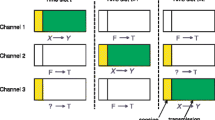Abstract
We propose a method for calculating the parameters of the resulting discrete channel for secondary users in cognitive radio systems formed by the algorithm for minimizing channel switchings. The availability of channel slots is defined by a simple Markov chain. We obtain mathematical expressions for determining the transition probabilities of a graph reduced to two states for any number of primary channels.
Similar content being viewed by others
References
Ghosh, G., Das, P., and Chatterjee, S., Cognitive Radio and Dynamic Spectrum Access—A Study, Int. J. Next–Generation Networks, 2014, vol. 6, no. 1, pp. 43–60.
McHenry, M.A., NSF Spectrum Occupancy Measurements Project Summary, Shared Spectrum Company Report, Vienna, USA, 2005.
Huang, S., Liu, X., and Ding, Z., Opportunistic Spectrum Access in Cognitive Radio Networks, IEEE INFOCOM Conf., Phoenix, USA, 2008.
Huang, S., Liu, X., and Ding, Z., On Optimal Control for Opportunistic Spectrum Access of Cognitive Radio Networks, IEEE INFOCOM Conf. 2010, San Diego, CA, USA.
Ferrari, L., Zhao, Q., and Scaglione, A., Utility Maximizing Sequential Sensing Over a Finite Horizon, IEEE Trans. Signal Process., 2017, vol. 65, no. 13, pp. 3430–3445.
Li, B., Yang, P., Wang, J., Wu, Q., Tang, S., Li, X.–Y., and Liu, Y., Almost Optimal Dynamically–Ordered Channel Sensing and Accessing for Cognitive Networks, IEEE Trans. Mobile Computing, 2014, vol. 13, no. 10, pp. 2215–2228.
Zhao, Q., Krishnamachari, B., and Liu, K., On Myopic Sensing for Multi–Channel Opportunistic Access: Structure, Optimality, and Performance, IEEE Wireless Commun., 2008, vol. 7, no. 12, pp. 5431–5440.
Hueda, M.R. and Rodriguez, C.E., On the Relationship Between the Block Error and Channel–State Markov Models in Transmissions Over Slow–Fading Channels, IEEE Trans. Commun., 2004, vol. 52, no. 8, pp. 1269–1275.
Zhang, S., Wang, H., and Zhang, X., Estimation of Channel State Transition Probabilities Based on Markov Chains in Cognitive Radio, J. Commun., 2014, vol. 9, no. 6, pp. 468–474.
Thakur, P., Kumar, A., Pandit, S., Singh, G., and Satashia, S.N., Performance Analysis of Cognitive Radio Networks Using Channel–Prediction–Probabilities and Improved Frame Structure, Digital Commun. Networks, 2018, vol. 1, no. 8, pp. 1–9.
Melent’ev, O.G. and Shevnina, I.E., A Comparison of Algorithms for the Choice of Logical Channel with Priorities, Elektrosvyaz’, 2010, no. 2, pp. 50–52.
Zhao, Y. and Bail, L., Performance Analysis and Optimization for Cognitive Radio Networks with Classified Secondary, Mobile Inform. Syst., 2017, no. 3613496, pp. 1–8.
Melent’ev, O.G. and Kleiko, D.V., Computing the Parameters of the Discrete Channel Resulting under Frequency Hopping in the General Case, Autom. Remote Control, 2013, vol. 7, no. 7, pp. 1128–1131.
Csurgai–Horváth, L. and Bitó, J., Primary and Secondary User Activity Models for Cognitive Wireless Network, IEEE 11th Int. Conf. Telecomm., Graz, Austria, 2011.
Barnes, S.D. and Maharaj, B.T., Performance of a Hidden Markov Channel Occupancy Model for Cognitive Radio, IEEE Africon Conf., Livingstone, Zambia, 2011.
Melent’ev, O.G. and Kleiko, D.V., Parameter Estimation of Logical Channels for Secondary Users, Nauchn. Vestnik NGTU, 2012, no. 4, pp. 56–62.
Zhangy, J., Liy, Y., Liuy, Z., Wuz, F., Yangy, F., and Wang, X., On Multicast Capacity and Delay in Cognitive Radio Mobile Ad–hoc Networks, IEEE Trans. Wireless Commun., 2015, vol. 14, no. 10, pp. 5274–5286.
Author information
Authors and Affiliations
Corresponding authors
Additional information
Russian Text © P.V. Krasheninnikov, O.G. Melent’ev, D.V. Kleyko, A.G. Shapin, 2019, published in Avtomatika i Telemekhanika, 2019, No. 2, pp. 101–110.
Rights and permissions
About this article
Cite this article
Krasheninnikov, P.V., Melent’ev, O.G., Kleyko, D.V. et al. Parameter Estimation for the Resulting Logical Channel Formed by Minimizing Channel Switching. Autom Remote Control 80, 278–285 (2019). https://doi.org/10.1134/S0005117919020061
Received:
Revised:
Accepted:
Published:
Issue Date:
DOI: https://doi.org/10.1134/S0005117919020061




